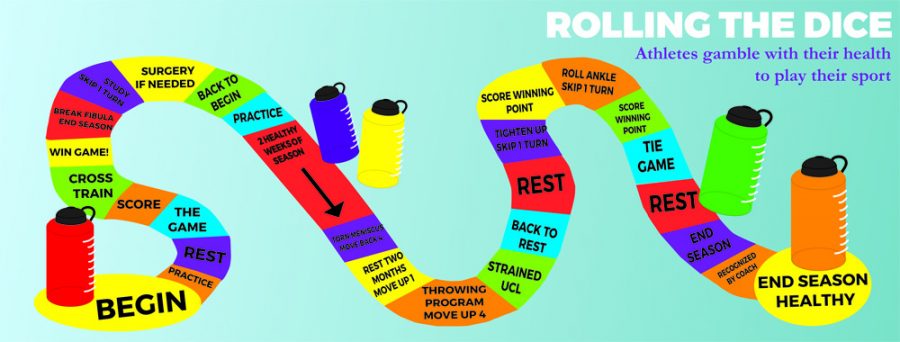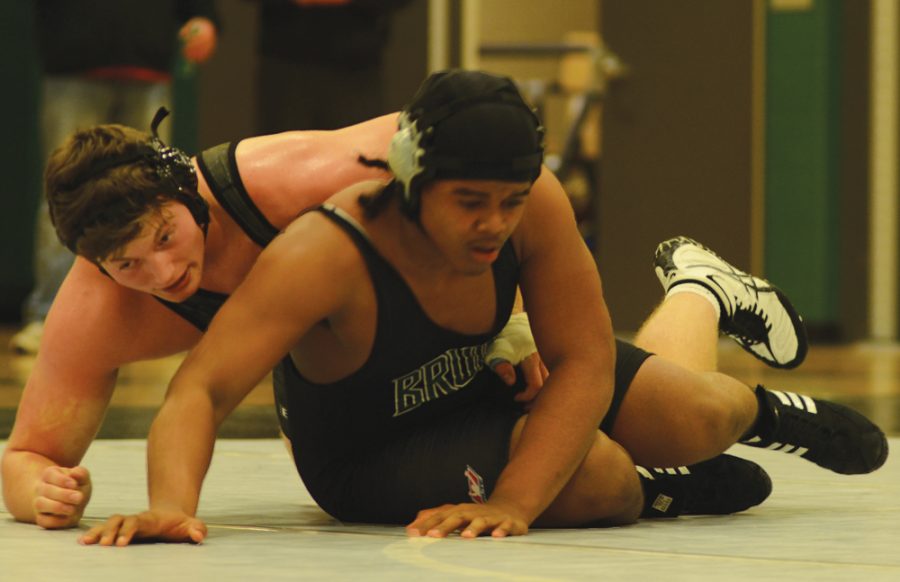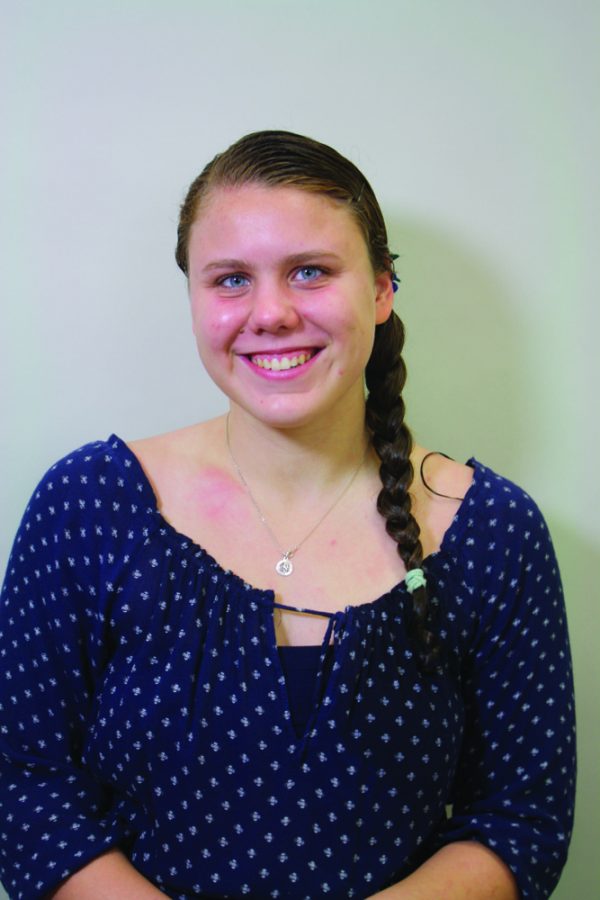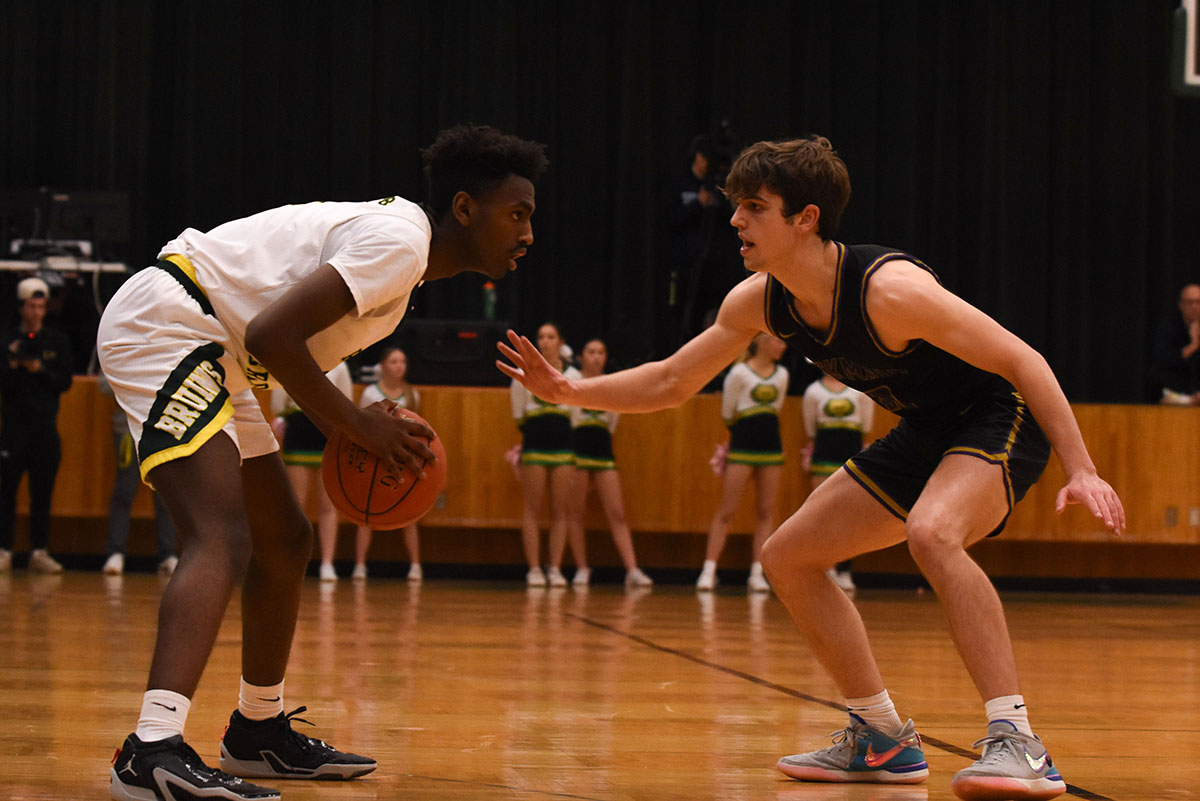art by Abby Kempf, Ana Ramirez and Shelby Yount
When stepping out onto the field, junior Nick Wohlbold thinks back to everything that led to this moment; the numerous baseball practices after school, the conversations between his teammates, and the years filled with triumphs and losses.
Determined to win, he visualizes himself at the plate, bat in hand. He narrows his vision as the ball is pitched. He swings and watches the ball rebound across the field. A moment later, he dashes toward the next base and before he knows it, is approaching home plate.
However, the glory of playing the sport he loves soon started crashing to pieces during the offseason last year.
“I strained my [ulnar collateral ligament] from overuse a couple months before the season started,” Wohlbold said. “I was throwing and lifting while I should have been resting my arm for the offseason.”
After his injury, Wohlbold had to rest his arm for two months. Because he didn’t know if the injury was a temporary strain or something more serious, this time was filled with worry and angst.
“It was really difficult to completely rest it for two months. I couldn’t really do anything physical. I was really worried because we weren’t sure whether it was torn or just strained,” Wohlbold said. “After the two months of rest and treatment, Greg [Nagel] assured me it was just strained because of the drastic improvement shown. After I rested it, [he] gave me a throwing program that started off really light and easy, and then progressed into harder, more strenuous work.”
Nagel, head athletic trainer, worked closely with Wohlbold while he was in rehabilitation, saying his main focus was to guide him through the recovery process with rest, ice and outside community expertise.
“What I did with Nick was help him understand what the injury was and help him predict how long his rehabilitation would take and make a general recommendation for his activities so that he didn’t do anything that was unwise to injure his arm in further fashion,” Nagel said. “The last thing we would want to do is jeopardize his spring baseball season. We needed to handle this injury in October the right way, so I just helped him through that.”
The sports rehabilitation program at RBHS works to bring injured student athletes like Wohlbold back to their sport through stretching exercises and strengthening techniques. It also provides outside help from the community through doctor referrals.
“We see a bit of everything down here — strains, sprains, fractures, concussions — and it’s our job to monitor those and return those [student athletes] to play whenever it’s safe,” Nagel said. “We put athletes on treadmills and have them jump, twist, rotate and turn [to allow us to] evaluate just how functional they are and if they’re ready to return to sport or if we need to treat them more.”
Wohlbold is among many high school student athletes who have gotten injured playing their beloved sport.
Senior Karson Ringdahl was injured in late Sept. of this year while playing football, resulting in a broken fibula and a syndesmosis injury.
“It happened [as] I was running the ball and my cleat got stuck in the turf,” Ringdahl said. “Someone tackled me on my leg [while] my foot was stuck in the ground but my leg moved with it.”
About a week after his injury, he received surgery on his anterior cruciate ligament (ACL), one of the four main ligaments in the knee joint, that required doctors to put a plate and screws in his ACL as well as perform a tightrope procedure. To allow him full recovery, his doctors told him he could not play football for the remainder of the year.
Senior Mariah Fitzpatrick also tore her ACL along with her meniscus, the cartilage between the femur and tibia. But for her, it happened while she was playing volleyball during the second open gym in the preseason. She then got surgery to facilitate recovery.
“Since surgery, I [started going] to physical therapy about three times a week. It’s been a pretty slow process for me,” Fitzpatrick said. “At first the main focus of therapy was to get my range of motion back, but now they are really focusing on getting the strength back in my leg. I won’t be fully recovered until March.”
Fitzpatrick’s debilitating injuries have prohibited her from playing for the rest of the year. However, her love and devotion for her sport continues.
“I really miss playing volleyball, but I’m trying to make the best of the situation,” Fitzpatrick said. “I’ve been helping out with the RBHS team quite a bit this year. I would be playing if I could, though.”
Fitzpatrick is in a similar step in her recovery as Ringdahl, as both are still stuck between the bonds of recovery and time. Although he isn’t playing for his team, his teammates still support him as he continues to be a part of the sport from the sidelines.
“It’s not too much different [now that I’m in recovery],” Ringdahl said. “I still go to practice to be a leader and support all the guys.”
While Ringdahl is still in recovery, Wohlbold is resuming his time in baseball. However, he still has to be cautious of his injury.
“I have to pay a lot more attention to it now than I used to. My arm still tightens up occasionally from the injury and that’s when I know I have to shut it down. My velocity didn’t go down much from the injury though, which was good,” Wohlbold said. “I think it’s a matter of balancing the stress and recovery. I’ve been getting treatment on it this year a little because it flared up again, [but] with caution and rest, I don’t think it will impact me much in the future.”
As for Fitzpatrick, who is still in rehabilitation, the road to recovery is a process dependent upon healing and positivity, something that she struggled with in the beginning.
“I was really distraught for a while after my injury. I still have days now where I get really depressed that I can’t do things that other people can do easily,” Fitzpatrick said. “I think my teammates were pretty devastated when they found out I couldn’t play this year, but overall they have been really supportive and help keep me motivated to work hard and get healed up.”
Categories:
Injured athletes embark on road to recovery
November 4, 2015
1
0
Tags:
More to Discover



















































































Faaris Khan • Jan 19, 2016 at 11:22 pm
This was a really deep story, and I certainly enjoyed it. As a recreational athlete, I have dealt with my own personal injuries, albeit not as severe as the ones mentioned in this story. Chronic pain in my Achilles tendon forced me to stop doing what I love: basketball. Fortunately, two weeks of complete rest solved the issue, but injuries can be one of the most frustrating things to an athlete. I hope every athlete in this story has had a complete and successful recovery!